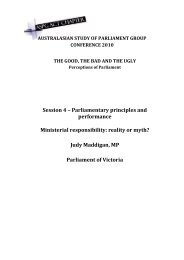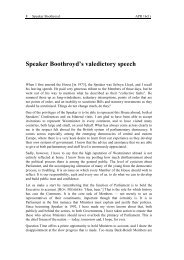Comic Commentators: Contemporary Political Cartooning in Australia
Comic Commentators: Contemporary Political Cartooning in Australia
Comic Commentators: Contemporary Political Cartooning in Australia
- No tags were found...
Create successful ePaper yourself
Turn your PDF publications into a flip-book with our unique Google optimized e-Paper software.
Spr<strong>in</strong>g 2009 Book pages 235check on power, cartoon<strong>in</strong>g is often its most potent weapon’. No surprise, then, thatThomas Nast, for example, (US 1840–1902), was seen ‘s<strong>in</strong>gle handedly to beresponsible for the downfall of the corrupt New York adm<strong>in</strong>istration of William‘Boss’ Tweed and his Tammany Hall r<strong>in</strong>g. 21 And that only David Low and Gabriel,(nomme de plume of Jimmy Friell), ‘strik<strong>in</strong>gly prescient’, provided any susta<strong>in</strong>edopposition to the Government at home and Fascists abroad <strong>in</strong> the lead up to WorldWar Two, though their warn<strong>in</strong>gs were largely ignored. 22In an article focused on the tribulations of work<strong>in</strong>g with <strong>in</strong>terfer<strong>in</strong>g editors and thelack of recognition for cartoonists like Peter Brooks and Steve Bell who, <strong>in</strong> hisview, are ‘more perceptive, accurate, engag<strong>in</strong>g and succ<strong>in</strong>ct analysts ofcontemporary events than Lord Rees-Mogg, Hugo Young, or any of the rest ofthem…’, British cartoonist, Mart<strong>in</strong> Rowson, deplores the ‘systematic failure with<strong>in</strong>newspapers to appreciate that cartoons are serious journalism’. 23 He argues thateditors can handle illustrators but worry about cartoonists (for which read editorialcartoonists as def<strong>in</strong>ed here) because they do their analytical th<strong>in</strong>k<strong>in</strong>g for themselvesand form their own op<strong>in</strong>ion. Rowson argues that if cartoonists are visual columnists‘then by def<strong>in</strong>ition they’re also op<strong>in</strong>ion formers’. Tony Walker agrees. In an article<strong>in</strong> the F<strong>in</strong>ancial Review Magaz<strong>in</strong>e of 31 October 2008 on cartoonist Pat Oliphant,he describes him as ‘a work<strong>in</strong>g journalist who has, arguably, had more <strong>in</strong>fluencedon how Americans see themselves — and how outsiders see America <strong>in</strong> the latetwentieth and early twenty first centuries than any other <strong>Australia</strong>n, <strong>in</strong>clud<strong>in</strong>gRupert Murdock. 24Although acknowledg<strong>in</strong>g the power of cartoons as the title of his chapter 7 ‘ThePower of Cartoons’ suggests, Michael Hogan worries about their fairness, theircynicism and their capacity to contribute to negative feel<strong>in</strong>gs <strong>in</strong> the communityabout politics. 25 So does Mark Thomas (‘cartoons can be corrosive’ p. 242) <strong>in</strong>chapter 14. Paradoxically, both, too, doubt their <strong>in</strong>fluence or their impact, but withexceptions. Hogan and Thomas, doubtless alert to Bell’s iconic image of JohnMajor with underpants outside his trousers, concede that cartoonists can have aprofound impact on the image of leadership. Like others, they agree that if a cartoon21 ‘Steve Bell <strong>in</strong> America’, reflect<strong>in</strong>g on his attendance at an AAEC Convention <strong>in</strong> Pittsburg<strong>in</strong> 2003, after which he concludes how much more organized and serious about protect<strong>in</strong>gtheir rights etc are the American editorial cartoonist)22 Peter Mell<strong>in</strong>i, ‘Fallen Angel The political cartoons of Jimmy Friell’, Cartoon History,http://www.politicalcartoon.co.uk/html/histoty/fallen-angel.html23 ‘We, the Cartoonists, are the True Outsiders of Journalism’, Cartoon History….He said hesees himself as a visual journalist rather than any k<strong>in</strong>d of ‘artist’. Mart<strong>in</strong> Rowson is acartoonist on The Guardian.24 Tony Walker, op. cit. Walker also refers to Chris Lamb’s book, ‘Drawn to Extremes: TheUse and Abuse of Editorial Cartoons’, Columbia UP 2004, the very title of whichsuggests the power and impact of the editorial cartoon.25 ‘Cartoonists and <strong>Political</strong> Cynicism’, The Draw<strong>in</strong>g Board: An <strong>Australia</strong>n Review ofPublic Affairs, Vol. 2(1), July 2001 pp. 27–50
















